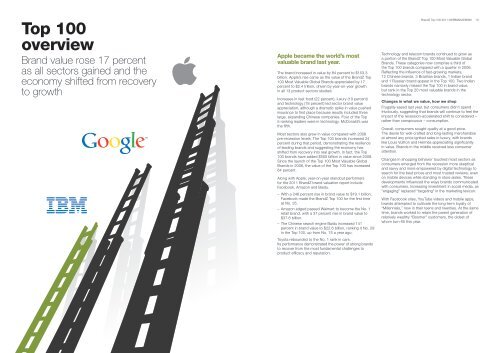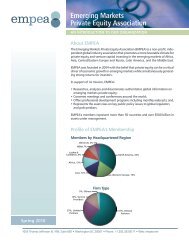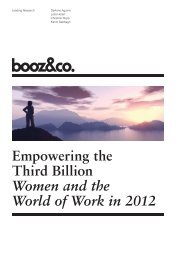Top 100 - Wamda.com
Top 100 - Wamda.com
Top 100 - Wamda.com
- No tags were found...
You also want an ePaper? Increase the reach of your titles
YUMPU automatically turns print PDFs into web optimized ePapers that Google loves.
<strong>Top</strong> <strong>100</strong>overviewBrand value rose 17 percentas all sectors gained and theeconomy shifted from recoveryto growthApple became the world’s mostvaluable brand last year.The brand increased in value by 84 percent to $153.3billion. Apple’s rise came as the value of the BrandZ <strong>Top</strong><strong>100</strong> Most Valuable Global Brands appreciated by 17percent to $2.4 trillion, driven by year-on-year growthin all 13 product sectors studied.Increases in fast food (22 percent), luxury (19 percent)and technology (18 percent) led sector brand valueappreciation, although a dramatic spike in value pushedinsurance to first place because results included threelarge, expanding Chinese <strong>com</strong>panies. Four of the <strong>Top</strong>5 ranking leaders were in technology. McDonald’s wasthe fifth.Most sectors also grew in value <strong>com</strong>pared with 2008pre-recession levels. The <strong>Top</strong> <strong>100</strong> brands increased 24percent during that period, demonstrating the resilienceof leading brands and suggesting the economy hasshifted from recovery into real growth. In fact, the <strong>Top</strong><strong>100</strong> brands have added $500 billion in value since 2008.Since the launch of the <strong>Top</strong> <strong>100</strong> Most Valuable GlobalBrands in 2006, the value of the <strong>Top</strong> <strong>100</strong> has increased64 percent.Along with Apple, year-on-year standout performersfor the 2011 BrandZ brand valuation report includeFacebook, Amazon and Baidu.– With a 246 percent rise in brand value to $19.1 billion,Facebook made the BrandZ <strong>Top</strong> <strong>100</strong> for the first timeat No. 35.– Amazon edged passed Walmart to be<strong>com</strong>e the No. 1retail brand, with a 37 percent rise in brand value to$37.6 billion.– The Chinese search engine Baidu increased 141percent in brand value to $22.6 billion, ranking it No. 29in the <strong>Top</strong> <strong>100</strong>, up from No. 75 a year ago.Toyota rebounded to the No. 1 rank in cars.Its performance demonstrated the power of strong brandsto recover from the most fundamental challenges toproduct efficacy and reputation.BrandZ <strong>Top</strong> <strong>100</strong> 2011: INTRODUCTION 10Technology and tele<strong>com</strong> brands continued to grow asa portion of the BrandZ <strong>Top</strong> <strong>100</strong> Most Valuable GlobalBrands. These categories now <strong>com</strong>prise a third ofthe <strong>Top</strong> <strong>100</strong> brands <strong>com</strong>pared with a quarter in 2006.Reflecting the influence of fast-growing markets,12 Chinese brands, 3 Brazilian brands, 1 Indian brandand 1 Russian brand appear in the <strong>Top</strong> <strong>100</strong>. Two Indianbrands narrowly missed the <strong>Top</strong> <strong>100</strong> in brand value,but rank in the <strong>Top</strong> 20 most valuable brands in thetechnology sector.Changes in what we value, how we shopFrugality eased last year, but consumers didn’t spendfrivolously, suggesting that brands will continue to feel theimpact of the recession-accelerated shift to considered –rather than conspicuous – consumption.Overall, consumers sought quality at a good price.The desire for well-crafted and long-lasting merchandiseat almost any price ignited sales in luxury, with brandslike Louis Vuitton and Hermès appreciating significantlyin value. Brands in the middle received less consumerattention.Changes in shopping behavior touched most sectors asconsumers emerged from the recession more skepticaland savvy and more empowered by digital technology tosearch for the best prices and most trusted reviews, evenon mobile devices while standing in store aisles. Thesedevelopments influenced the ways brands <strong>com</strong>municatedwith consumers, increasing investment in social media, as“engaging” replaced “targeting” in the marketing lexicon.With Facebook sites, YouTube videos and mobile apps,brands attempted to cultivate the long-term loyalty of“Millennials,” now in their teens and twenties. At the sametime, brands worked to retain the parent generation ofrelatively wealthy “Boomer” customers, the oldest ofwhom turn 65 this year.
















